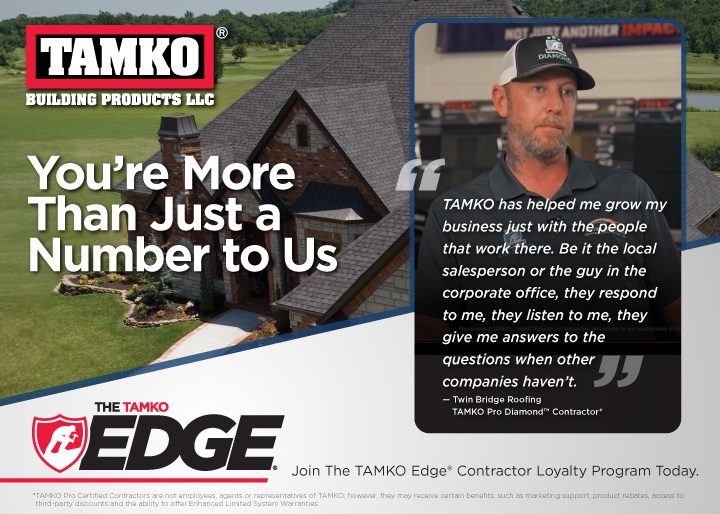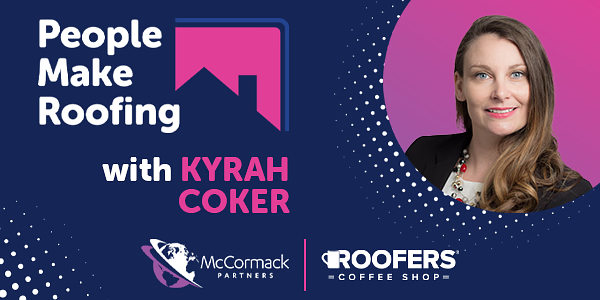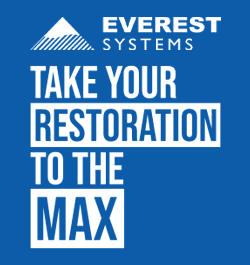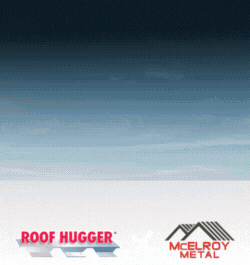Roofing Road Trip with Heidi- Charlie Smith - PODCAST TRANSCRIPTION

Editor's note: The following is the transcript of an interview with Charlie Smith from McElroy Roofing. You can read the interview below or listen to the podcast here.
Heidi Ellsworth: This is Heidi Ellsworth. I'm a partner at Roofer's Coffee Shop and I am just thrilled to be here today to talk metal. This is something, the art of metal and especially we're going to talk about recover. So from the expert in the industry, I am really happy to have Charlie Smith with McElroy Roofing here today. Charlie, welcome.
Charles Smith: Thank you. Glad to be here.
Heidi Ellsworth: Thank you for being here. You've told me some of your story. We've talked about it. I think it's incredibly interesting. So this is going to be fun to be able to share this with our listeners.
Charles Smith: Well, I'm looking forward to doing it, so let's get going.
Heidi Ellsworth: Okay, so let's get going. Well then, you know what Charlie? Start out with, you have a really cool history in the roofing business. Can you tell everybody about that?
Charles Smith: Well, basically I got into this business with absolutely zero experience. I was a geologist working in Ecuador for a few years after I got out of college, which was pretty cool for about two weeks. But after about three years it was ready to vamoose. So I got on a plane to come home and I had absolutely no idea what I was going to do. And landed in Houston and I thought, I'll probably just go down to visit with my dad for a while because he knows a lot of people and he may have an idea or something. So I took a cab down to his office and we were talking for about 10 minutes and then he walked out of the room to go the restroom. When he was gone, the phone rang and I picked it up and it was a guy that had a metal roofing business for sale. So this is a guy that we had known a long time before and he had a great story. He had been in this business for 10 years and it was going gangbusters. And then the last couple of years had a couple of big jobs that went south on him and the bank was after him and he was looking to get out. He said all the right things and I thought, this is a great opportunity. I had no idea what I was getting into, what a train wreck I was walking into. But anyway, one thing nice about doing something like that as I had no preconceived ideas on how to be in a metal roofing business, about manufacturing. Knew nothing about roofing to speak of. We had very limited space, we had some portable equipment. And so I took the equipment that I had and I was in the metal roofing business all of a sudden. One thing I heard someone say was that an expert is someone that made every possible mistake in a very narrow field. And I feel like I've done that. I've done that. One of the things that we did is we had this portable equipment and we had one basic place to manufacture. So we would take equipment in and out of the line to manufacturer roof panels or siding panels. What I learned was that if I wanted to be successful in the business that I had to be faster and a lot more nimble than the people that I was competing against. And so one of the things that I did was I had, as I developed my business, was to have inventory levels where I felt like I could produce a hundred flat sheets in any color for a contractor today and run a 40,000 square foot job in any color this week. If we could do those two things, then we could be faster than anybody else out there. And then the other thing was that we really wanted, I wanted to really develop this idea of site forming panels better than anybody. I built a couple of big trucks with scissor lifts on them that we could drive out to the job site and manufacturer the panels right onto the roof with a contractor. We had this system and I had this Willy Wonka kind of production facility that I was so proud of. I guess about year 15 I met a man that had been a general manager of General Motors. He had been a manager of a General Motors manufacturing plant for 30 years. And I thought, man, this guy knows a thing or two about manufacturing, I need to invite him over to show him my place. And so I finally got him to come over and he was in there for about 10 minutes and I was expecting this raving review. And he said, "You know, I would be really impressed if I was a cave man." Talk about a gut punch, boy. He helped me really find a different direction, very simple things to help me understand the manufacturing business better. But anyway, so about eight years later I sold my business to McElroy Metal, which was a great thing for, I think, for both of us. They've given me the freedom to do the things I like to do, which is figure out how to solve problems and [crosstalk 00:06:14].
Heidi Ellsworth: McElroy Metal is such a great company and for them to see how you can bring a really unique advantage, I just love those stories. So thank you for sharing that. I love to hear how people got into roofing and I don't think you're a cave man anymore, Charlie. So I think you're all good there.
Charles Smith: [inaudible 00:06:39] cave man stick.
Heidi Ellsworth: I doubt that. But you know what? You are well known in the industry for being a huge advocate of roofing contractors and really encouraging them to use metal roofing in nonconventional ways. Can you talk a little bit about that? Share what you're doing in that realm.
Charles Smith: Well this kind of all started with this idea of being able to site form roof panels and how do we take site forming into jobs that really fit that picture as far as site forming. I mean, new construction on metal buildings is not conducive to site forming panels. You might think about they need really to be site formed because to get rid of the in laps because I don't want any in laps on any roof that I ever do. But site forming metal roof panels onto open purlins as is a very slow and tedious process. So the best building type to manufacturer metal roof panels onto are going to be, let's say, 20 to 25 foot eave height with a lower slope where people can move around freely and the risk is real low, nobody's going to fall and they're on a solid deck. And so that really leads us into recover work. Not so much new construction, but recover work. And so I really focus my effort on how to really put new roofs on top of existing sloped roofs. Preferably lower sloped roofs because it's just faster and easy to make the panels, it's faster and easy to install those things on. So I focused on low slope recover and particular direct application over single plies and that... Which was what nobody really does that, but we did. We did many millions of square feet of that type of work where we put some methods together to put a roof directly over the top of single ply on a half inch or quarter inch slope. So when you looking at doing that type of work, you've got problems with curbs on low slopes and so what I wanted to do was figure out how to do a job like that and issue a warranty on it and be confident in the warranty. And so we came up with some methodology to flash curbs where we lifted all the curb flashing up out of the water plane where there was no water ever going to see a curb. Instead of running the water into the back of a curb and around a curb, we just lifted the curb flashing up out of the curb and took the area up hill to the curb and eliminated any water flow coming into the curb. We do that with a method, we call it transverse panel. It's interesting and it works great and then we can use that type of idea on a lot of different applications as well. And then we also use the combination of different materials to provide the desired outcome on the job as well. So if we had a big giant stack sticking out of the roof where metal is just really difficult to work with around that, then we could use PVC clad metal and then integrate that into our standing seam roof or into these transverse panels and then heat weld all the joints around this big stack or irregular shaped curb or a bunch of stacks in one place where you could get the areas of the roof that needed to be maintained down to the smallest possible area. So you could take a 100,000 square foot roof and maybe have 200 square feet of single ply on it in areas where really the very difficult stuff to flash using metal was where we mitigated our risk by reducing the areas of concern down to the smallest possible area. So, that's one of the ways that we looked at nonconventional ways to use metal and we're very successful at it and I continue to look at those opportunities all the time.
Heidi Ellsworth: Yeah, that's cool. Yeah, and that's really looking at something and solving some problems, which I mean, and then putting such a... Obviously a metal roof is so sustainable and long term. But also before we move on to the metal, I really want to focus in on some of these solutions that you've come up with. You have patents, right? Patents on some of these.
Charles Smith: I've got, I think, five patents on different methods for doing recover and a couple of them have been very successful. A couple of them are total dogs, you know? Not all ideas are great ideas, I can say that much. Fortunately the good ones have outweighed the bad ones.
Heidi Ellsworth: I love it. How can contractors use those good ones? How are they using those in their recover jobs?
Charles Smith: Well, just talk about recover. I mean, I think about just recover in general and one of the big things for me is, I'm not a big giant of tree hugger, but the idea of the fact that I have personally diverted millions of cubic yards from being put in the landfill by doing recover, which I think is an enormous deal. That if you can encapsulate an existing roof, leave it in place and put something on top of it that should last 50 or 60 years, which is what they're projecting gaveling to go out right now, then I think it's a great thing. I mean, you're talking about there's nothing that lasts longer than a good, well installed standing seam metal roof but the gaveling itself right now, they're projecting to go out 60 plus years. They have done a lot of studies on that. The other thing for me now is I have just focused in, I only use one type of roof panel now. I've gotten away from all the snap seam, I don't use any exposed fastener panels on anything ever. I don't use snap seam panels. I don't use snap seam panels because I want my roof to be watertight. The idea of a water shedding roof means nothing to me. I want a watertight roof panel whenever I do something. And so that gets you into mechanically seamed panels. Double lot panels are great, but their biggest flaw is that you cannot repair them. Once they're installed, they're done. So it's just you've got seam problems, you've got any of those issues going on that it's very difficult to repair one of those roofs. So I'm just strictly now focused on, I use symmetrical T shape standing seam panels. We make one that's two and three eights inch tall, we call 238-T. We make one that's one and three eight inch tall, we call it a 138-T. But these symmetrical panels offer some enormous advantages. They're more watertight than a traditional panel because there is no sealant breaks in the seam like you have with a traditional double lot panel. The double lot panels, you get a break in the sealant wherever there's a clip located in the seam. These panels get way better wind up lift than any other roof systems. Most importantly, they're easy to fix if there's ever an issue because you know there's issues. I mean, you've got a roof that's going to last 50 or 60 years, shit's going to happen.
Heidi Ellsworth: Right.
Charles Smith: The idea of being able to pull an individual panel out of that roof at a later date is an enormous deal.
Heidi Ellsworth: Yeah.
Charles Smith: So if the owner wants you to add curbs later, you want to add a curb later, you can pull the roof apart and put the curb in properly instead of having some backwater lap bandaid curb on top of there. So easy to fix, add curbs, and then from an installation point of view, they're much more... It gives you a lot more flexibility on installation. You can start wherever you want to. Start in the middle, work your way out. You can jump curbs, come back and backfill holes later. So, there's all kinds of advantages to using symmetrical panel. If anybody listening to this had never tried one, you need to try it sometime. Just because it's kind of hard to... It's like everything is different so you get used to it. But once you get used to it, it's really, I think, a way better system. So as far as recover, one of the big issues right now is the new energy code. The energy code really dictates if you do a remove and replace on a job or if you do a new construction that you have to meet the current energy codes, which can be quite onerous, which can be an enormous amount of insulation. I'm looking at a job right now, they want 12 inches of batt insulation in this roof. It's like crazy. Okay?
Heidi Ellsworth: Yeah.
Charles Smith: But if you do recover, you don't have to do that. You're in control of how much insulation is put into this new roof, whether it's to fill the cavity or you have a vented air space. I mean, but you're in control and the owner's in control, not a government agency, which I like that idea. Another thing we find is that screw down panels, if you have an existing metal building that has screw down panels on it, what a lot of people don't realize is that those panels on that metal building are part of the structure. They're holding the building square so you cannot just take off an R panel and put a standing seam on a metal building. If you do that, you're liable to end up in a king size problem. So I always find that if the existing building has a screw down panel, like an R panel holding the roof on that's on the roof, I always want to try to leave that thing in place because it is part of the structure. It's what's helping keep the walls from falling in. So I always leave it in place, recover it. And there's a number of different ways to do it. That one of the patented ways that we have is a tall clip system where we use a clip that sits between the ribs of the existing roof panel, it holds the new roof panel up above the ribs of the existing panel. So an R panel has got ribs 12 inches on center. So we run a 24 inch wide panel, it's aligned in between the ribs of the existing R panel. The clip sit down between the ribs of the R panel attached to the purlin and then we infill with insulation in between the two roofs. This thing goes down super fast and it can be very price competitive with single ply recover. You're talking about a roof that ought to last 50 or 60 years and you can fix it real easy, it goes down real fast and it's very price competitive. That's been, by far, the best patent that I've gotten is this tall clip recover system.
Heidi Ellsworth: Tall clip recover. I love it. That's cool.
Charles Smith: It is. It is beautiful, man. And then a lot of people like putting single ply's on building on metal buildings and I know it's very popular, but just understand that a metal building is not designed for that; it's designed for a metal roof. A metal roof channelizes the water off the building, it provides equal loading across the entire structure where a single ply does not do that. And it's about understanding purlin deflection. I wrote an article, there's probably four articles out in the space dealing with this subject. There's been a number of collapses as a result of doing this. So just be aware, don't just do that stuff blindly. Understand what you're doing and what the effects of that stuff can be. And another thing that we see this pretty alarming is this putting a 10 foot wide sheet of membrane on a metal building with purlins at five foot on center so you're attaching this membrane to every other purlin. That's called skip loading and metal buildings are definitely not designed for skip loading on wind up lift. So it's really important that if you're in a situation that's what you're going to do then you probably want to use a narrower sheet and attach it to every purlin instead of every other purling. I'm not going to go on and on about that, but just do your research.
Heidi Ellsworth: No, I think that's-
Charles Smith: Do your research.
Heidi Ellsworth: Yeah, that's great. That's great information. The four articles you have out there, we'll make sure those are on Roofers Coffee Shop. And I know that you have been very instrumental in writing the RCI metal roofing courses and being a part of really bringing education on what you're talking about to the industry. Take it that next step forward. How can contractors, you said do their research, but how can they get to work with what you already have out there in training their crews and really understanding the best systems?
Charles Smith: Well, I mean, right now everybody's probably got a little bit more time on their hands.
Heidi Ellsworth: Right.
Charles Smith: Because of the situation going on out there. I mean, I do webinars all the time and I'm happy to do webinars for any contractor that wants to do a webinar that wants to educate their people, number one. Number two, there's articles out there that I've written as well as other people have written on all kinds of retrofit subjects. And then I was just looking. I wrote the RCI course, the RCI metal roofing course with a guy named Brian Gardiner. He and I have written a number of articles together and one of the best things for me has been to go at... I go normally go two or three times a year out and I teach this metal roofing course. So I've been able to influence hundreds of roof consultants on certain aspects of metal roofing. Some of the pitfalls and things to stay away from. Actually, Brian and I wrote a couple, did a couple of courses as well. One was the top 10 things that would get a metal roofer in trouble. One was the 10 things that'll get a metal roof designer in trouble. And both of those, we've had a lot of lot of positive feedback on both of those courses because it just points out this stuff that we just try to keep you out of the sling, man because there's all kinds of ways to get in trouble with metal roofing. It's nice if you understand some of the things that, at least in our experience, that hopefully keep you out of that stuff. So there's all kinds of information out there.
Heidi Ellsworth: That is great. As part of McElroy Metal and with the company and with all your initiatives, I know you're in charge of business development. What are you seeing? What are you with this recover movement? Are you seeing a lot of contractors taking this into their business and how successful are they?
Charles Smith: Well, I see a lot of contractors that are doing recover because, let's just face it, there's probably five to one existing new construction jobs out there. So, it's like you get an existing building that has a problem, then as the contractor you're faced with you may be the first guy to get called out there to fix this problem. And if it's a metal building, then you got three or four different options there. What we want is for you to understand that there's at least eight or ten different ways to put a new metal roof on a metal building. There's not just one, there's not just two. There's a bunch of different ways. And so, I look at a job and every job is completely different in my mind, and so you have to... I go look at a job and then I go in there with these 10 different ways and then as we look at the job and then I narrow it down to what is going to be the best way to solve this person's problem based on their budget, based on the loading requirements, based on the wind up lift, based on the snow load, based off of the purlin spacing, the condition of the building. You have to look at a whole host of things. And what's the budget? So all those things are important. The areas where I see the most success is for sure metal building recover and in particular R panel recover with this tall clip system has been very, very successful. And then we also have a shingle recover system that I developed to go over the top of shingles and I don't really see this as a residential deal, although it can be, certainly can be a residential deal. But we've done an enormous number of schools and military work, churches and whatnot where the idea with this system is that we have developed a clip that sits on two shingles and holds so that it sits in the correct roof plane. And then it also holds the panel up three quarters of an inch so that we can provide a fully ventilated air space between the bottom of the roof panels and the top of the shingles. And what that does is that is it helps reduce the heat transfer through the metal roof, or through the shingles, into the attic space. And so the guys at Oak Ridge have done a a lot of experimenting on this and a lot of testing on this and they figured out that you can reduce... If you put a three quarter inch down to a three quarter inch air space, ventilated air space above a shingle roof, below a metal roof, that you can reduce the heat transfer through by 30 to 45% depending on the color of the roof that you chose. I did some of my own testing and came up with very similar numbers on some pretty good sized mock ups that we built. So it's pretty amazing. I mean, we got it where it was 100 degrees outside and we had the attic space inside this mock up that we built at 104 with this ventilated roof system over the existing roof. And then where it was 140 when there was nothing except the shingles. So it was a pretty nice system for reducing heat transfer and then not having to tear the shingles off and giving you a much better roof.
Heidi Ellsworth: Yeah. I love that because so many homeowners and building owners, and you really touched on this, that as the contractors are going in to the building owners and homeowners, there's so many benefits on why to do a recover, whether it's for heat, for insulation, for not landfill, saving the landfills, I mean just overall costs. And a lot of times I know that what we hear, just like you said, is just go over with some single ply. But this is an option that really can appeal to building owners and homeowners for the longterm. I think this is great, Charlie. How do the contractors get to... I know they're going to go to McElroy Metal, and they also are going to go on the Roofers Coffee Shop to find you. But this tall clip system, is this something that is just available through McElroy or how do they take the next step to start incorporating this in their business?
Charles Smith: Well, probably the best thing is to get in touch with me and then we can talk about what's the best method for us to deliver this to them? We can do it a number of different ways and just kind of get a strategy together if they feel like there's a business opportunity there for them. But we've put together a number of different methods for delivery that we can make this work with. I like to be involved with the job just to kind of make sure it gets steered as far as so we understand what is going to be the best method to solve the problem for the owner. But the tall clip over an R panel is certainly one of the very best ones for the budget and for long longevity and make it quit leaking. Because they just wanted to quit leaking at some point. That's the nice thing about recover. They're less concerned about the upfront cost if the water's pouring in on their brand new piece of equipment. So we think there's a tremendous opportunity. Another thing I want to say, just about recover in general is that I get a lot of calls about, "Well I've got an existing standing seam roof. Trapezoidal standing seam roof up here on this building. What's it going to cost to recover this thing?" There can be a huge variation in the cost of doing a retrofit over a trapezoidal standing seam. And it 100% depends on the existing on the clip offset of the existing roof panel, which means how high above the purlin is the existing roof panels sitting? We have to know that. You don't want to figure it out later. I was working with a guy yesterday. The price difference between the method to if we're dealing with a one inch offset or a six inch... A one inch offset between the bottom of the roof panel and the top of the purlin and a three eighths inch offset, it was like $150,000 worth of material on one job. So it's enormous. So you have to understand that. If you're going to look at a standing seam roof that's existing and you want to retrofit it, then let's figure out what that clip offset is first and then we can come up with the best method because there's a lot of ways to do it, we just need to know the offset.
Heidi Ellsworth: Excellent. Charlie, thank you so much. I've learned a lot. This is incredibly helpful and educational. I want to our listeners who are watching, we're going to have on Charlie's information, his bio, some information, some links to all the items that he's worked on. It will all be on the McElroy Metal directory in Roofer's Coffee Shop along with their website and contact information. So this will be a great way. We're going to also, watch out for from this podcast, we're going to have some blogs. We're going to invite Charlie to come into our metal forum and so we'll really have a chance to continue this conversation. Charlie, thank you so much for being here today. I so appreciate it.
Charles Smith: Heidi, thanks for asking me and you have a great day. Okay?
Heidi Ellsworth: You too. And thank you everyone for listening. This is Roofing Road Trips with Heidi and my guest, Charlie Smith of McElroy Metal. I am so happy that you were here today and I'm so happy that all of you were able to listen and hopefully learned as much as I did. Be sure to listen to all of our podcasts that are on the read list and watch initiative on Roofer's Coffee Shop and have a great day. Thank you so much for being here.






















Comments
Leave a Reply
Have an account? Login to leave a comment!
Sign In